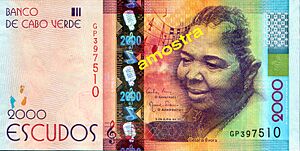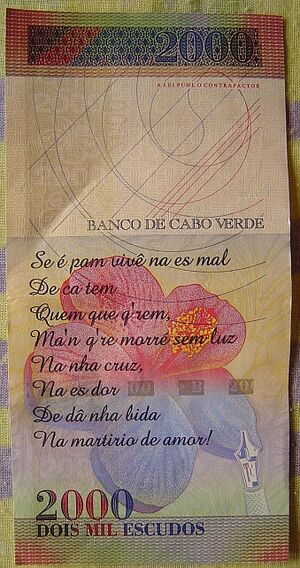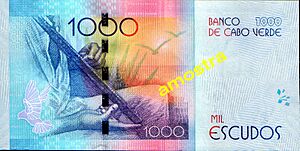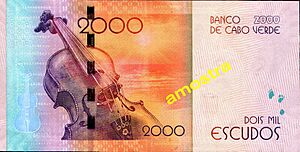Cape Verdean escudo facts for kids
Quick facts for kids Cape Verdean escudo |
|||
|---|---|---|---|
|
|||
| ISO 4217 Code | CVE | ||
| User(s) | |||
| Inflation | 0.6% | ||
| Source | September 2015 | ||
| Pegged with | euro (1 EUR = 110.265 CVE) | ||
| Subunit | |||
| 1⁄100 | centavo (discontinued) | ||
| Symbol | |||
| Coins | |||
| Freq. used | 5, 10, 20, 50, 100 escudos | ||
| Rarely used | 1, 200, 250 escudos | ||
| Banknotes | 200, 500, 1000, 2000, 5000 escudos | ||
The escudo (sign: ![]() ; ISO 4217: CVE) is the currency of the Republic of Cape Verde. One escudo is subdivided into one hundred centavos.
; ISO 4217: CVE) is the currency of the Republic of Cape Verde. One escudo is subdivided into one hundred centavos.
Amounts are generally written by using the cifrão (![]() ) as the decimal separator, such as 20
) as the decimal separator, such as 20![]() 00 for 20 escudos, or 1.000
00 for 20 escudos, or 1.000![]() 00 for 1000.
00 for 1000.
History
The escudo became the currency of Cape Verde in 1914. It replaced the Cape Verdean real at a rate of 1000 réis = 1 escudo. Until 1930, Cape Verde used Portuguese coins, although banknotes were issued by the Banco Nacional Ultramarino specifically for Cape Verde beginning in 1865.
Until independence in 1975, the Cape Verde escudo was equal to the Portuguese escudo. Subsequently, it depreciated, declining by about 30 per cent in 1977–78 and by a further 40 per cent in 1982–84. Thereafter, it remained fairly stable against the Portuguese escudo.
In mid-1998 an agreement with Portugal established a pegged rate of 1 Portuguese escudo = 0.55 Cape Verdean escudos. Since the replacement of the Portuguese escudo with the euro, the Cape Verdean escudo has been pegged to the euro at a rate of 1 EUR = 110.265 CVE. This peg is supported by a credit facility from the Portuguese government.
Coins
Under Portuguese rule, coins were introduced in 1930 in denominations of 5, 10, 20 and 50 centavos and 1 escudo. The 5, 10 and 20 centavos were struck in bronze whilst the 50 centavos and 1 escudo were in nickel-bronze. In 1953, bronze 1 escudo, nickel-bronze 2+1⁄2 escudos and silver 10 escudos were introduced, followed by bronze 50 centavos and nickel-bronze 5 escudos in 1968.
After independence, coins were issued in 1977 in denominations of 20 and 50 centavos, 1, 2+1⁄2, 10, 20 and 50 escudos. The centavo coins were aluminium, the 1 and 2+1⁄2 escudos were nickel-bronze and the higher denominations were cupro-nickel. As inflation persisted the centavo coins progressively disappeared from circulation and by the time the coinage was revamped the 1 escudo coin was the smallest in circulation.
The present coinage was introduced in 1994. The smallest was a brass-plated-steel 1 escudo, though the 1 escudo does not circulate well and vendors tend to round to the nearest five in practice. This coin comes in only one style, featuring a sea turtle, while the other denominations came with three topical styles. These are the copper-plated-steel 5 escudos, nickel-plated-steel 10, 20 and 50 escudos, and bimetallic, decagonal 100 escudos. The three congruent design series had one featuring native animals (Birds and reptiles), the second was of historical ships with their names included, and the last was of native plants and ferns. Heptagonal 200 escudo coins have been issued in 1995 to commemorate the 50th anniversary of FAO and 20 years of independence. Another 200 escudo coin, this time round was issued in 2005 to commemorate the 30th anniversary of independence. Circulation of the 200 escudo coin is not quite as widespread as the other denominations but they are still commonly distributed and accepted alongside the 200 escudo note.
Banknotes

In 1914, the Banco Nacional Ultramarino introduced notes in denominations of 4, 5, 10, 20 and 50 centavos. In 1921, notes for 1, 5, 10, 20, 50 and 100 escudos were issued. The next series of notes, introduced in 1945, omitted all denominations below 5 escudos (which had been replaced by coins) and included 500 escudo notes. 10 escudo notes were replaced by coins in 1953, with the 5 escudo note also withdrawn.
After independence on 5 July 1975, notes were issued for 100, 500, and 1000 escudos on 1 July 1977. The next series of notes was introduced in 1989 and consisted of 100, 200, 500, 1000 and 2500 escudos.
The third series was introduced in 1992 in denominations of 200, 500, 1000, with the addition in 1999 of 2000 and 5000 escudo notes. In 2005, the 200 escudo note was redesigned, followed by the 500 and 1000 in 2007.
On 22 December 2014, the Banco de Cabo Verde introduced a new series of banknotes that honor Cape Verdean figures in the fields of literature, music, and politics. It consists of denominations of 200, 1,000 and 2,000 escudos issued in 2014, with the former now printed on polymer, and banknotes of 500 and 5,000 escudos issued in 2015.
Historical exchange rates
| Date | Brazilian real | euro1 | Portuguese escudo2 | United States dollar |
|---|---|---|---|---|
| 1995 | – | – | 1⁄1.93 | 76.853 |
| 1996 | – | – | 1⁄1.90 | 82.591 |
| 1997 | – | – | 1⁄1.90 | 93.177 |
| 1998 | – | – | 0.55 (fixed rate) | 98.158 |
| 1999 | – | 110.265 (fixed rate) |
0.55000 | 102.700 |
| December 1999 | – | 0.55000 | 107.285 | |
| 2005 | – | obsolete | about 90 | |
| February 2006 | about 40 to 50 | about 90 | ||
| April 2006 | about 40 to 50 | – | ||
| January 2007 | 39.86 | 85.36 |
- currency created on 1 January 1999; not in circulation until 1 January 2002
- currency no longer legal tender as of 1 March 2002
| Current CVE exchange rates | |
|---|---|
| From Google Finance: | AUD CAD CHF EUR GBP HKD JPY USD |
| From Yahoo! Finance: | AUD CAD CHF EUR GBP HKD JPY USD |
| From XE.com: | AUD CAD CHF EUR GBP HKD JPY USD |
| From OANDA: | AUD CAD CHF EUR GBP HKD JPY USD |
| From fxtop.com: | AUD CAD CHF EUR GBP HKD JPY USD |
Note: These rates are obtained from xe.com and may contradict with pegged rate mentioned above
See also
- Currencies related to the euro
- Economy of Cape Verde






